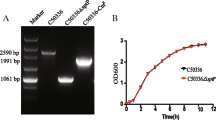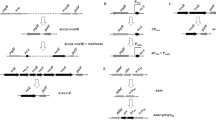Abstract
An auxotrophic mutant which requires a metabolite not available in vertebrate tissues should be unable to grow in such tissue and thus be non-virulent. Most mutations to auxotrophy do not affect virulence1–3, presumably because the required metabolites are available at sufficient concentration. However, Bacon et al.1,2 noted that a Salmonella typhi mutant requiring p-amino-benzoic acid (p AB) was less virulent (for mice) than its parent. Salmonella, unlike vertebrates, cannot assimilate exogenous folate and must synthesize it from p AB; the virtual absence of p AB from vertebrate tissues is shown by the efficacy of sulphonamide chemotherapy. Yancey et al.4 reported reduced virulence for a S. typhimurium mutant with a requirement for 2,3-dihydroxybenzoate (DHB), the precursor of the bacterial iron-acquisition compound, enterochelin. As DHB is not a known vertebrate metabolite, it would be expected to be absent from mouse tissues. Salmonella synthesize p AB and DHB from chorismate, the final product of the aromatic biosynthetic (aro) pathway. A complete block at any step of this pathway should make S. typhimurium auxotrophic for two compounds not available in vertebrate tissues, and thus non-virulent. We describe here the use of a tetracycline-resistance transposon, Tn10 (refs 5, 6), inserted in gene aroA to produce non-reverting, aromatic-requiring derivatives of virulent S. typhimurium strains. These derivatives were virtually non-virulent; their use as live vaccines conferred excellent protection against challenge with a virulent strain.
Similar content being viewed by others
References
Bacon, G. A., Burrows, T. W. & Yates, M. Br. J. exp. Path. 31, 714–724 (1950).
Bacon, G. A., Burrows, T. W. & Yates, M. Br. J. exp. Path. 32, 85–96 (1951).
Herzberg, M. J. infect. Dis. 111, 192–203 (1962).
Yancey, R. J., Breeding, S. A. & Lankford, C. E. Infect. Immun. 24, 174–180 (1979).
Kleckner, N., Chan, R. K., Tye, B. & Botstein, D. J. molec. Biol. 97, 561–575 (1975).
Kleckner, N. Cell 11, 11–23 (1977).
Schmieger, H. Molec. gen. Genet. 119, 75–88 (1972).
MacPhee, D. G. & Stocker, B. A. D. J. Bact. 100, 240–246 (1969).
Robson, H. G. & Vas, S. I. J. infect. Dis. 126, 378–386 (1972).
Kleckner, N., Roth, J. & Botstein, D. J. molec. Biol. 116, 125–159 (1977).
Kleckner, N., Reichardt, K. & Botstein, D. J. molec. Biol. 127, 89–115 (1979).
Wray, C. & Sojka, W. J. Res. vet. Sci. 25, 139–143 (1978).
Bochner, B. R., Huang, H., Schieven, G. & Ames, B. N. J. Bact. 143, 926–933 (1980).
Björk, G. R. J. molec. Biol. 140, 391–410 (1980).
Wahdan, M. H. et al. Bull. Wld Hlth Org. 58, 469–474 (1980).
Author information
Authors and Affiliations
Rights and permissions
About this article
Cite this article
Hoiseth, S., Stocker, B. Aromatic-dependent Salmonella typhimurium are non-virulent and effective as live vaccines. Nature 291, 238–239 (1981). https://doi.org/10.1038/291238a0
Received:
Accepted:
Issue Date:
DOI: https://doi.org/10.1038/291238a0
- Springer Nature Limited
This article is cited by
-
The oncolytic bacteria-mediated delivery system of CCDC25 nucleic acid drug inhibits neutrophil extracellular traps induced tumor metastasis
Journal of Nanobiotechnology (2024)
-
A two-step activation mechanism enables mast cells to differentiate their response between extracellular and invasive enterobacterial infection
Nature Communications (2024)
-
Assessing microbiome population dynamics using wild-type isogenic standardized hybrid (WISH)-tags
Nature Microbiology (2024)
-
Comparative Transcriptomic Analysis of Flagellar-Associated Genes in Salmonella Typhimurium and Its rnc Mutant
Journal of Microbiology (2024)
-
Safety assessment of compliant, highly invasive, lipid A-altered, O-antigen-defected Salmonella strains as prospective vaccine delivery systems
Veterinary Research (2022)





